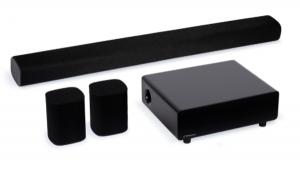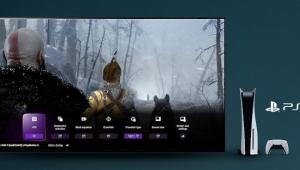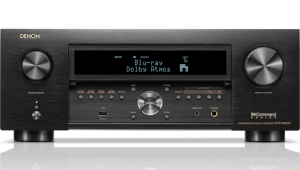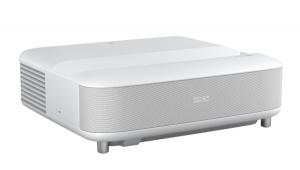Test Report: Sonus Faber Liuto Speakers and REL R-528 Subwoofer Page 2
Test Bench
Frequency response
• tower 43 Hz to 20 kHz ±5.8 dB, 300 Hz to 10 kHz ±1.5 dB
• center 90 Hz to 20 kHz ±13.0 dB, 300 Hz to 10 kHz ±2.6 dB
• mini 56 Hz to 20 kHz ±7.6 dB, 300 Hz to 10 kHz ±1.7 dB
• subwoofer 35 to 94 Hz ±3 dB
Sensitivity (SPL at 1 meter/1 watt)
• tower 88.2 dB
• center 89.0 dB
• mini 84.1 dB
Impedance (minimum/nominal)
• tower 4.1/7 ohms
• center 6.1/8 ohms
• mini 6.2/9 ohms
Bass output, tower (CEA-2010 standard)
• Ultra-low bass (20-31.5 Hz) average: 90.5 dB
20 Hz: 83.0 dB
25 Hz: 91.1 dB
31.5 Hz: 97.3 dB
• Low bass (40-63 Hz) average: 114.7 dB
40 Hz: 108.1 dB
50 Hz: 115.6 dB
63 Hz: 120.3 dB
Bass output, subwoofer (CEA-2010 standard)
• Ultra-low bass (20-31.5 Hz) average: 98.3 dB
20 Hz: NA
25 Hz: 98.7 dB
31.5 Hz: 112.5 dB
• Low bass (40-63 Hz) average: 118.8 dB
40 Hz: 117.0 dB
50 Hz: 118.7 dB
63 Hz: 120.6 dB
Bass limits
• center 25 Hz at 81.4 dB
• mini 25 Hz at 78.6 dB
I measured the Sonus Faber Liuto speakers without grilles at a distance of 2 meters — adequate to incorporate the contributions of all drivers and cabinet diffraction. The Liuto tower sat atop my measurement turntable, while the Liuto Smart center and Liuto Monitor minispeaker sat atop a 6-foot stand to give quasi-anechoic results down to 240 Hz.
The curves in the graph show the average of responses at 0°, 10°, 20°, and 30°, smoothed to 1/12th of an octave. I close-miked the woofers and ports of all speakers, then scaled and summed the results to get each speaker’s bass response. (I double-checked these sums by running ground-plane bass measurements.) I then spliced the bass responses to the averaged quasi-anechoic responses to produce the curves you see here. To measure the frequency response of REL’s R-528 subwoofer, I close-miked the woofer and passive radiator and combined the two responses to produce the curve you see here. The Liuto tower, center, and minispeaker responses are normalized to 0 dB at 1 kHz, the REL subwoofer normalized so that its peak response shows as +3 dB.
Starting with this review, I’ve made a change in the way I measure tower speakers. In keeping with practices previously established in S+V, I had been measuring tower speakers to take into account “floor bounce”: the cancellation/reinforcement (i.e., dip and peak) effect that occurs when the sound bouncing off the floor interferes with the direct sound from the speakers. I’ve decided to stop doing this, for three reasons.
First, the frequencies at which floor bounce occur vary with the listening distance. A normal listening distance is 50% to 100% farther than my usual measuring distance of 2 meters, so the floor-bounce effects you experience will almost certainly be at different frequencies than the ones shown in our measurements.
Second, floor-bounce effects occur with stand-mounted minispeakers and center speakers, too. Including floor-bounce effects only in the tower speaker measurements treats tower speakers unfairly.
Third, I know of no manufacturer or other media outlet that includes floor bounce in its tower speaker measurements.
Some treble rolloff and mild bass boost make the full-band response numbers of these speakers less impressive, but if you narrow the window to the crucial frequency range of 300 Hz to 10 kHz, the speakers’ measurements are among the best I’ve seen. The Liuto tower is especially remarkable, measuring ±1.5 dB from 300 Hz to 10 kHz. Its off-axis response is nothing short of incredible; at 45° and 60° off-axis, there’s the usual treble rolloff above 10 kHz, but the response is essentially flat below that. I can’t recall ever seeing such good off-axis response, certainly not from a speaker without a real (i.e., 3- or 4-inch) midrange driver. The grille has relatively slight effects: –2.8 dB dip at 4 kHz, +2.6 dB boost at 6 kHz, and +2.8 dB dip at 9 kHz.
My comments on the Liuto Monitor minispeaker are essentially identical; it’s as perfect a match for the Liuto tower as it could be.
The Liuto Smart center does almost as well out to 30° off-axis; its averaged response from 300 Hz to 10 kHz is ±2.6 dB. Further off-axis, though, the dual midwoofers start to interfere with each other, producing dips averaging about 15 dB between 700 Hz and 2.3 kHz.
Impedance for all Liuto models is reasonable. The Liuto tower drops to a minimum of 4.1 ohms at 100 Hz, with a phase angle of –23°. The Liuto Smart center hits minimum impedance at 6.1 ohms at 4.3 kHz, with a phase angle of –10°. The Liuto Monitor minispeaker drops to a minimum of 6.2 ohms at 20 Hz, with a phase angle of +4°, but it’s unlikely that this small speaker would ever be subjected to a high-level 20-Hz signal anyway.
Average sensitivity from 200 Hz to 10 kHz at 1 watt (2.83 volts) at 1 meter is good for the Liuto tower and Liuto Smart center, but the Liuto Monitor minispeaker’s sensitivity is somewhat low at 84.1 dB. This is no big problem — 64 watts will get you to 102 dB — but this isn’t the best minispeaker to use with a low-powered tube amp.
I scoffed when Sumiko president John Hunter suggested that I could set the Liuto Smart center and Liuto Monitor minispeaker to “large” in my receiver’s bass-management menu, but he was right: These little guys can take a lot of low-frequency signal. Both the center and the mini deliver measurable (meaning, below CEA-2010 bass distortion thresholds) bass output all the way down to 25 Hz, although neither can play loud at that frequency.
I measured bass output of the Liuto tower and the REL subwoofer using the CEA-2010 method. I powered the Liuto with a Carver A-400x amplifier bridged to deliver 500 watts of power. Measurements were made on the ground at 2 meters; +6 dB was added to the results to approximate measurements at 1 meter.
The Liuto tower’s woofer and enclosure almost seem like they were designed specifically to deliver the “punch” in movie soundtracks. Output in the low bass octave (40-63 Hz) is outstanding for a relatively small tower speaker, averaging 114.7 dB and peaking at 120.3. Output is much weaker in the ultra-low bass (20-31.5 Hz) octave, but it’s still there, even all the way down at 20 Hz.
REL’s R-528 subwoofer has plenty of power in the low bass (40-63 Hz) octave, averaging 118.8 dB. At these frequencies, a limiter circuit clamps down on maximum output and keeps distortion extremely low; I could barely see any distortion harmonics in the spectrum analysis graph when I did the CEA-2010 measurements. I’d estimate this sub would be capable of 4 to 6 dB more output from 40-63 Hz if the limiter wasn’t set so conservatively. Output in the ultra-low bass octave (20-31.5 Hz) was okay, averaging 98.3 dB, but I wasn’t able to get any usable output at 20 Hz. (I got the ultra-low bass number by averaging the results at 31.5 and 25 Hz, plus the 25-Hz result minus 15 dB as per CEA-2010 practice.)
Frequency response of the subwoofer shows substantial rolloff below 30 Hz and above 90 Hz. This measurement was made with the crossover frequency at the maximum setting of 120 Hz. The output is down 12 dB (–15 dB from peak) at 120 Hz, indicating that the crossover frequency control isn’t accurately calibrated. The combined low-pass function of the driver and crossover circuit is –24 dB/octave.
- Log in or register to post comments



















































